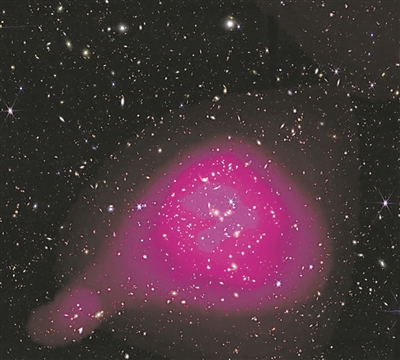

A galaxy cluster over 6 billion light-years across. Image credit: European Space Agency
An international team of astronomers has discovered the largest sample of galaxy clusters ever detected in a region of the sky called COSMOS-Web using data from the James Webb Space Telescope. The study marks a major milestone in extragalactic astronomy, providing unprecedented insights into the formation and evolution of galaxies and the large-scale structure of the universe. The new image catalog, published in the latest issue of the journal Astronomy & Astrophysics, contains information on nearly 1,700 galaxy clusters.
The images cover a period from about 12 billion years ago to 1 billion years ago, capturing galaxy clusters more than 6 billion light-years away, some of which were named the best pictures of the month by the European Space Agency. The research team used the Webb telescope to detect 1,678 galaxy groups or protoclusters, the largest and deepest sample of galaxy groups ever collected. This allows researchers to study the evolution of galaxy groups over the past 12 billion years.
Groups and clusters of galaxies are complex environments containing dark matter, hot gas, and massive central galaxies, often hosting supermassive black holes. The interactions between these components are crucial to the life cycle of galaxies and the evolution of the groups and clusters themselves. By revealing the history of these cosmic structures, astronomers can better understand how they influence the formation and development of large-scale galaxies and the largest structures in the universe.
Galaxies are not evenly distributed throughout the universe, but tend to cluster in dense regions connected by filaments and walls, forming the so-called "cosmic web." Truly isolated galaxies are rare, and most galaxies are found in small-scale groups, typically containing three to a few dozen galaxies, or in larger clusters that may contain hundreds or even thousands of galaxies bound together by gravity. For example, the Milky Way belongs to a small collection of galaxies, the Local Group, which includes the Andromeda Galaxy and other smaller galaxies.
Just as people form families, galaxies gather to form groups. Groups and clusters of galaxies are important because the galaxies within them can interact and merge, leading to changes in the galaxy's structure and morphology. Studying these environments helps us understand the role of dark matter, the effects of supermassive black holes, and the history of the hot gas that fills the space between galaxies.
Because the new star catalog covers observational data from 1 billion to 12 billion years ago, scientists can now compare the earliest structures in the universe with more recent structures, thereby gaining a deeper understanding of galaxy clusters and their evolution. Studying the history of galaxy clusters can also help astronomers explore how the huge and brightest galaxies at the center of galaxy clusters, the main galaxies of galaxy clusters, were formed through repeated mergers. This research result not only expands people's understanding of the universe, but also opens up new avenues for future research.
(Original title: "Important milestone in extragalactic astronomy, Webb telescope observes the largest galaxy cluster sample in history")
hcTk ANCHPVhz ITl olKGbZO wxYjmEt